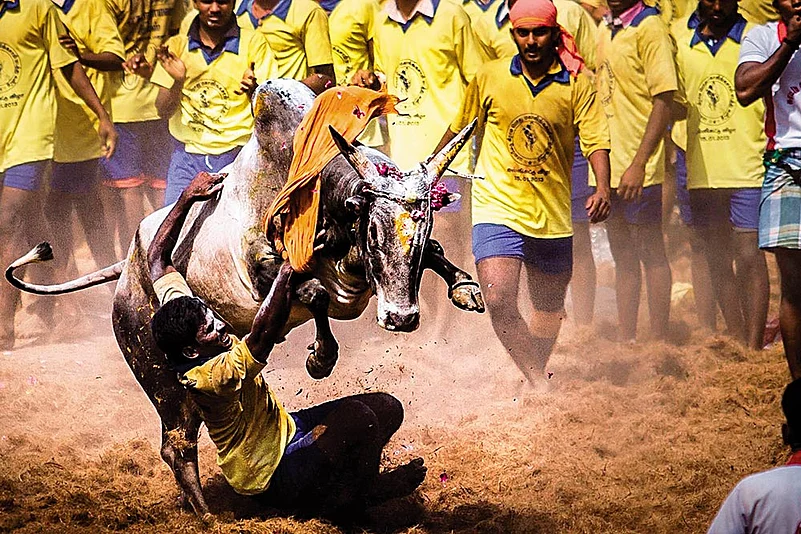In January 2017, Tamil Nadu had its largest show ever—the Jallikattu protests on Chennai’s Marina Beach and across the state. What started off as a leaderless protest quietly got hijacked by groups preaching Tamil separatism. Once the main demand of staging Jallikattu was met and the protests lost its focus, organisers ended it with a violent clash with the police.
But the demonstrations underlined that a people’s protest on the lines of Anna Hazare’s anti-corruption rally and the Nirbhaya agitation could be staged in Tamil Nadu even on a non-people issue like Jallikattu. Journalist N. Sathiya Moorthy, a researcher with the Observer Research Foundation, has attempted to peel through the layers of the protest in this book. Unfortunately, for someone known for his erudite analysis of South Asian politics, he has only scratched the skin of the bull.
The author rightly avers that the collective angst triggered by the ban on Jallikattu, imposed by the Supreme Court, was a culmination of a series of events when the state watched helplessly as its interests got compromised one after another. The impunity with which Karnataka ignored the SC’s diktat to release Cauvery water and the Centre’s refusal to constitute a Cauvery River Water Authority as dictated by the SC had already created an undercurrent of anger against the Court and the NDA government.
Also, emotionally, the state was grappling with Jayalalitha’s death and the aftermath of the power struggle between Sasikala and O. Panneerselvam. So, when the SC put the brakes on Jallikattu yet again, the bubble burst. Sathiya Moorthy records how the reach of the social media was used by the few thousands present on the first two days to increase numbers to nearly a lakh. The author should also have noted that TRP hungry Tamil news channels kept the pot boiling with 24-hour coverage, with hyperventilating reporters shouting from amidst protestors.
In what’s a strong point, the author explores the antiquity of Jallikattu, quoting its presence from early Sangam-era Tamil works like Tholkappiyam and over 2,000 years ago. “Jallikattu has both poetry and grammar going for it,” confirms Sathiya Moorthy, pointing out that the ancient sport, Eru Thazhuvudhal (hugging the bull), found repeated mention in ancient Tamil literature.
The book establishes the religious significance of the bull and cow. The author quotes from Srimad Bhagavatham, that narrates Lord Krishna’s life in Sanskrit: “...an episode in which Krishna tames not one bull but seven, as ordained by a local ruler, who had been rearing them with great care only for the swayamvaram of his daughter”.
The economic and emotional link between cattle and the farmer in a largely agrarian economy are detailed well—grand temples, for example, sheltered both animals and humans during times of floods. It was only natural that during peace time, when warriors had no wars to fight, “Jallikattu became a sport for the young Mukkulathore men to display their prowess in public and prove their valour”.
The author recollects Tamil Nadu’s penchant for protests from anti-Hindi agitation of the ’60s, the token fasts held by its Dravidian chief ministers, the anti-Lanka agitations and the more recent anti-nuclear protests at Koodankulam and how the Jallikattu agitation itself spawned protests at Neduvasal against exploration of hydrocarbons and the anti-NEET protests after the suicide of a Dalit girl.
The book, however, throws very little light on how the faceless and nameless organisers managed to sustain the Marina protest for a week, the key players who defused the crisis and the reason for the violence on the last day. If only the author had substantiated his narrative with interviews and quotes from the supporters and opponents of Jallikattu and had talked to intelligence officials, he could have added real meat to his story. Instead, there is a laborious attempt to add pages by stringing together other unconnected events involving Abdul Kalam and Rajnikanth in the narrative.
The book also suffers from a repetitive mention of events and surmises while attempting to nail the real reason for the angst. Even conspiracy theories of the pro-Jallikattu lobby, that foreign companies are out to destroy the native breed of bull, find only passing mention rather than a close scrutiny. Sathiya Moorthy parts with a warning shot that “the governments, policy-makers and the political class as a whole cannot still overlook socio-political sentiments, and continue to think that it is business as usual”.
He probably fears that the faceless protesters have not withdrawn completely from the battlefield and could be planning yet another agitation.


























